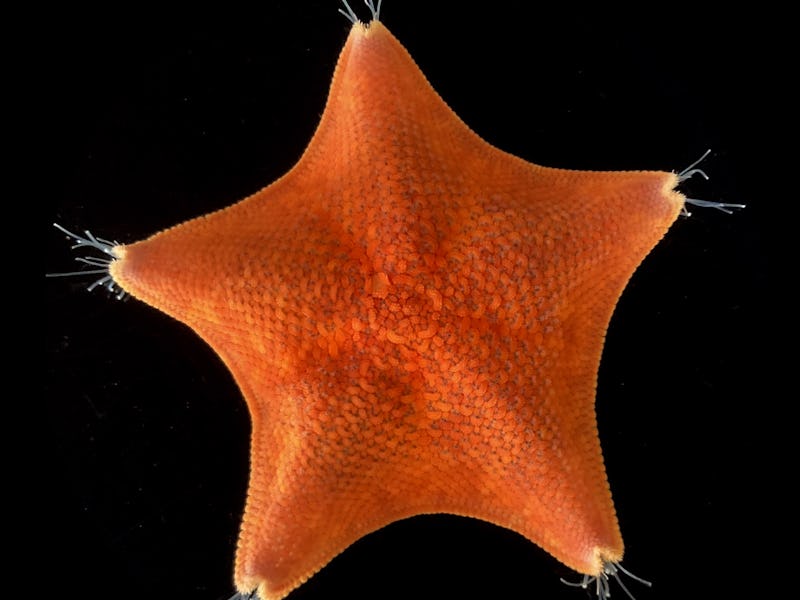New Genetic Study Reveals Sea Stars Are Just A Bunch of Heads Smushed Together
How this iconic animal got its shape has been an ongoing mystery for biologists.

Along the ocean floor lives an unusual multi-armed creature. No, not the octopus, the starfish: an animal from the echinoderm family known for its spines and bumps and, most importantly for some members, its celestial silhouette.
Many animals — humans included — have a bilateral body plan, meaning if you’re split down the middle, you get roughly two symmetrical halves. Being the extra marine prima donnas they are, echinoderms have a pentaradial body plan, which means their bodies are arranged in a pattern that repeats five times around a central axis. But here’s the thing: echinoderms are part of a bigger family called deuterostomes (which means “second mouth”), many of whom enjoy a bilateral symmetry. This has had scientists wondering how echinoderms like starfish evolved from their humble bilateral origins to end up with their five-armed bodies.
These findings suggest for whatever reason, over the course of their evolution, sea stars lost their bodies to become only heads.
Now, in a study published Wednesday in the journal Nature, an international team of researchers combed through the genetic code of the bat star to find some unexpected answers. Genes turned on in the starfish’s body were somewhat similar to deuterostomes, with the middle part of each arm being like the “head” region. However, the researchers couldn’t find any gene expression that would correspond to the "trunk" or middle part of a bilateral body plan. These findings suggest for whatever reason, over the course of their evolution, sea stars lost their bodies to become only heads.
“It’s as if the sea star is completely missing a trunk and is best described as just a head crawling along the seafloor,” Laurent Formery, the study’s lead author and a postdoctoral researcher at Stanford University’s Hopkins Marine Station, said in a press release. “It’s not at all what scientists have assumed about these animals.”
Switching up the genetic blueprint
Over the years, biologists have proposed numerous theories to explain how this iconic animal got its shape. One idea is that echinoderms essentially repurposed their ancestral genetic blueprint to do new things with their development, such as creating their unique pentaradial body plan.
Another idea is that they maintained the same deuterostome genetic blueprint but still modified it a bit. For instance, they may have duplicated the genes involved in the head-to-tail axis, giving rise to their many arms. Another is that the echinoderm’s top-to-bottom axis (from mouth to the opposite side) is the same as the front-to-back axis of their ancestors. This idea mostly comes from looking at where certain genes are active in echinoderm larvae.
The problem is that echinoderms are so weirdly different that even basic genetic and fossil comparisons with other animals are tough. So, Formery and his colleagues looked at how certain genes that control body layout, called Hox genes, are used in a starfish called Patiria miniata, aka the bat star. These Hox genes are pretty ancient and usually don't change much across different animals, including humans. They’re like an IKEA instruction manual responsible for setting up the head, torso, and tail regions, passed down through many millennia of evolution.
The researchers found that the patterns of gene activity in the juvenile bat star didn't match up with what they expected based on how these genes work in other animals. Instead, they found a completely new pattern that they called the "ambulacral-anterior" model.
In this model, the genes active in the human forebrain and similar areas in bilaterally shaped animals were active along the center of the sea star's arms or ambulacra. The genes active in the human midbrain were active closer to the edges of the sea star's arms. There were hardly any genes turned on that typically direct the development of the trunk region, except for one in the itty-bitty tips of the sea star’s arms.
It’s not clear why echinoderms evolved this way, but the researchers think it's more likely that the marine animals evolved their strange body plan through a long process of small changes rather than a big, sudden repurposing of genes. They also mention that looking at fossils of some ancient echinoderms, which seem to be halfway between having bilateral and radial symmetry, might help us understand better how this process happened. The researchers also want to investigate whether this genetic patterning appears in other echinoderms like sea urchins and sea cucumbers.
“These results suggest that the echinoderms, and sea stars in particular, have the most dramatic example of decoupling of the head and the trunk regions that we are aware of today,” said Formery. “It just opens a ton of new questions that we can now start to explore.”